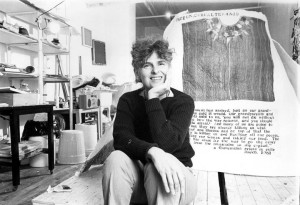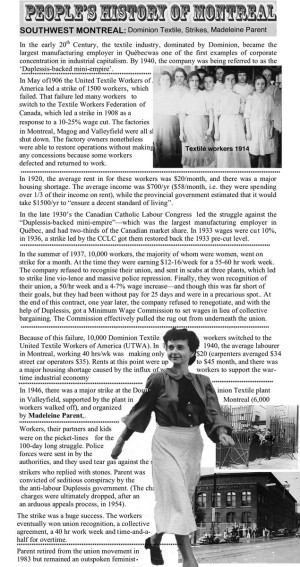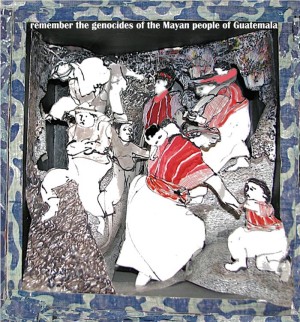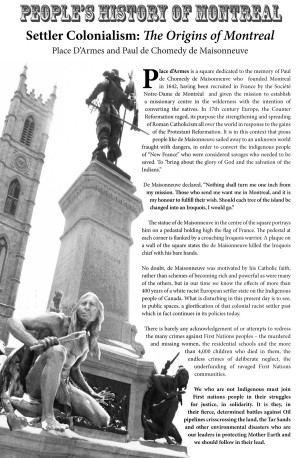Freda Guttman, veteran Montreal artist and activist
“One advantage of having had the good fortune to live into old age is that I can look back and see my life in art and activism as a story, a journey, one that begins with three facts about myself as a child: I was aware in some way of being in opposition to the society I grew up in; I was keenly interested in what was happening in the world; and I knew that what happened in the world had, in some way, an impact on my small life.
“This longevity, (for which I am grateful!), offers me the opportunity to reflect on personal intentionality and processes of engagement against changing social and political backdrops. …
“In the early 1970’s, I made artwork that satisfied me enough that I could consider myself an artist. I followed the pattern of what artists do – work, apply for grants, apply for shows, try to sell work. And although my work had feminist themes, it would be an exaggeration to characterize it as ‘political art’ engaged in the arena of struggles for equality. I was at the time a member of the first women’s artist run centre in Canada, Powerhouse, (which later became La Centrale) and I participated in women’s consciousness-raising groups. Women’s Liberation was in the air, but it was a middle-class, white movement, in my experience. Similarly, although we demonstrated against the Vietnam War and some of us helped War Resistors coming from the US, I now see these kinds of actions as being reactions to events without a deeper analysis of historical imperialism, neo-imperialism, capitalism and racism, without the development of strategies for bringing about systemic change that we see so widespread today. Different times!
“… In 1990 I was interviewed in an art magazine, Harbour… I was asked how I saw the future development of political art. At the time, I felt very much alone as an artist, dealing with political issues and trying to place my work within an activist framework. I said that I hoped that in the future there would be a large community of activist artists that I could be a part of. My wish has come true. Now as never before there is a richly textured resistance culture, which anyone can be part of without having to call themselves artists or feel that they need special training or permission to do art. …
“I have lived many changes in perceptions of what art is and for whom, how is it can be commodified and how it can be used as a powerful tool of social mobilization for justice. Art is now posters, graffiti, street art, knitting, installations and performances in public places, taking over a space and any creative endeavour that one can think of. Today, when there are so many more activists/artists involved in struggles through different patterns of collective organizing as part of the global community of activists, we can only rejoice! … We are much better equipped to speak truth to power and reach others than ever. And are needed more than ever. Art is needed more than ever now.”
What follows is an edited transcript of a conversation between Freda Guttman and Louis Rastelli at the Archive Montreal archive centre in the summer of 2015.
LR: What part of town did you grow up in?
FG: Outremont. I was very different.
LR: It’s associated with a fairly upscale…
FG: Not the part where I lived. It was upscale francophone, but the part where I lived was the Jewish community, people that had emigrated from various times in the 20th century. I would say that they were middle, middle-class. A lot of them had factories and so on, but it was French and Jewish, and because of the separate school systems, we had nothing to do with each other. In fact, we considered each other enemies, you know how kids do, but I never knew a francophone until I was an adult. I never went east of St-Laurent until I was an adult. It was like a completely different city. I grew up in a ghetto, and the Protestant School that I went to was all Jewish. I went to Outremont High.
LR: Was it as Hassidic as it is today?
FG: No, the Hassidic community was very small, I think they came here after the war [WW2] — I never saw them around. Back then, nobody even wore kipas. It was “making it’, like starting a new life, that’s what they got away from. They weren’t like the Jewish immigrants that went to New York and were like anarchists, socialists, social activists and fought for unions, they were like a merchant class.
LR: Do you remember the 80 streetcar on Park?
FG: Yeah! Well I was born in 1934, I’m 81. So I remember like, girls couldn’t wear shorts on the street, it was still pretty rigid that way. It was a whole different world.
LR: Did you have any sense of being in an Anglophone community?
FG: There weren’t Anglophones, just Jews & Francophones. I spoke English but not Hebrew. They tried to force me to go to Hebrew school, but I rebelled– I once tore up my Hebrew book and left it in a field and didn’t go to the class. A few days later, I had to go back, because the principal called me in and he handed me the two halves of my book (laughs). We called it an orthodox Jewish, but there wasn’t much religiosity about it, and it was a very enclosed community.
LR: By the time you were a teenager, did you feel the urge to bolt, to flee?
FG: Yeah! I think I did from the time I was very young. Feel like I was different. My parent’s friend’s girls graduated from high school and got married at 18. I was 28 when I got married and I married a non-Jew, so I always had the sense of being different and not belonging, and wanting out (laughs). My last two years of high school, we moved to Westmount [in the late 1940s], and it was the first time I had anything to do with non-Jewish people. I felt a little bit more in the real world because I got to know people who weren’t Jewish.
LR: Did Sherbrooke Street impress you more than say Bernard or Van Horne? Do you remember the Mile-End with the little shops…
FG: Yeah! There was Ben’s that had smoked meat sandwiches. It was on Van Horne, right near Wiseman where I lived. And my father was very strict about eating food that was bad for you, so my sister and I used to sneak in and eat sandwiches (laughs). I used to wander to Park Avenue around Van Horne & Bernard and roam the 5 and 10 stores a bit.
LR: I guess there would have been a lot of wholesale shops, and cafes?
FG: I don’t think there were really cafes then. I didn’t really eat, I mean, I would buy candy and stuff, but honestly… Montreal has transformed in so many ways…
LR: Was it normal for you to go to university back then?
FG: No it wasn’t. I sorta bummed around at McGill for a year, mostly sat in at courses, but then I went to the States to study art for three years at the Rhode Island School of Design.
LR: What got you interested in studying the visual arts?
FG: It was just something innate in me that I wanted to do. I never could draw representationally well, and I never thought I needed to. There was almost a need for self-expression because I was a depressed person, it sort of goes along with being an outsider. I didn’t know where I belonged and that kinda fulfilled me, made me feel that I had a purpose. I would look at art books, go to museums and be inspired by art, and that was just a need that I had. All the choices I made were odd for someone coming from my community… like not getting married until I was 28. I didn’t live up to my parents’ expectations for me, and I suffered from it too, in a way, but I knew that I didn’t want what they wanted for me. After art school, I went to teacher training at MacDonald College and that was a joke, but then I started teaching, which I liked a lot. I taught first at Verdun High School where I met my future husband, but they had never seen a Jew before… it was very working class, very Irish & Scottish.
LR: Once you became a teacher, I guess your parents must have been at least comfortable that you had a career?
FG: Well, no. I think I was a big disappointment to them, but that was their problem! My parents were worried about me and what was going to happen… you know, their preference would have been for me to have married a nice Jewish boy who had money and have kids and grandchildren.
LR: Did you ever discover any of the beatnik things, like poetry readings in the cafes?
FG: A bit. I tried to find the kind of people who were like on the extreme-left, and activists, who were into culture.
LR: From 1956 to ’66, did you get the sense that the world had really changed?
FG: It did for me! The ‘60s coming along, I couldn’t believe it! The conformity, the separation between men and women… Life magazine published an article like: “Johnny can’t read because his father does the dishes” –It was that extreme, really. So when the ‘60s came, I was just like WOW!
LR: When you came back to Montreal, did you manage to find any interesting art scene?
FG: No. I wasn’t even really doing art then after I graduated. It took a few years before I started to teach. In the ‘70s when the Powerhouse gallery began, I joined it. I taught one year at Verdun, and then at Montreal High for two years. Later on I taught at Concordia and then at Dawson.
LR: Was it in the early ‘60s that you stopped teaching and got married?
FG: Yeah, and my kids were born in ’63 & ’65 and I got married two years before. Later on we marched against the Vietnam war, I was involved in women’s consciousness-raising groups. At the time, draft evaders were coming up here and my husband was part of a group that helped them come across the border. Not that there was any danger, but just to help them.
LR: Do you recall the student movements, the Sir George computer riots?
FG: I didn’t have any part in it, but I recall it. I think typically, the women’s movement was white and middle class, but I wasn’t doing the kind of activism that I am today, and my politics weren’t as radical. With the ‘60s I suddenly felt like everybody was like me, a whole world of people thinking like me.
LR: How did you find out about the first artist-run centres, places like Véhicule?
FG: I was friends with one of the founders, and I joined shortly after it started. I did work at Graff on Rachel, At one point I did a lot of photo etchings… you have a piece of metal and you cover it with like emulsion and then expose it, it’s just like making a photograph… they had a nice set up to do that there, but other than that, I was never a full-fledged member. And what was crazy was, the chemicals we used are not sold today because they’re so toxic. We used to put our hands right in it, and there was no ventilation for the fumes…
LR: You mentioned that you became a member pretty early on of Powerhouse?
FG: Yeah, almost at the beginning and I was very active in it. It was on St-Dominique at Pine Avenue. It since burned down, that building. It was the first feminist gallery in Montreal.
LR: Somebody that I spoke with told me that the whole artist-run movement possibly wouldn’t have happened if it were not for the whole feminist side of it, and came about in part because of the snubbing of all of the mainstream galleries to female artists.
FG: I think too, a lot of it was to counter-balance the commercial galleries… where political art could be shown. So, the other factor was that there was funding then, which is greatly reduced, both for artists and for artist-run centres. The centres were a source of a lot of good work and creativity. People would apply to have a show, and there would be a jury.
LR: Aside from those engravings, what other kinds works do you recall doing?
FG: Just different kinds of printmaking, some linocuts, silkscreen, a lot of photo etchings. In the ‘80s I made a decision that I would do art that was political but also art that would stay in the gallery… I did a very big one about Guatemala at Powerhouse… the was a US-arranged coup there in ’53. A lot of people know about Chile but this was like 20 years earlier, and there was genocide. What I did was have important speakers from Guatemala come and we had a whole bunch of events, concerts to raise funds. You know… Karen Young, people like that… we had talks and all kinds of events, just to get it out of the gallery. Then I did one called The Global Menu and was about the global system of food production—like who feeds who? So actually those in the early ‘80s…
LR: Did you sense that there was a wider lull of political art or political awareness, say after the end of the Vietnam War and the beginning of the ‘80s? Did you get a sense that there was less of a charged atmosphere of political causes as there was in the early ‘80s where there was a lot of awareness of the injustices in South America?
FG: Yeah, I knew the refugees here—I worked with the Guatemala refugee group. In Montreal, it wasn’t all that accepted to do political art and to speak for others—it was called cultural appropriation—so, there were critical people, but I didn’t give a shit because I just wanted to be a political activist in that way. There was much more of it in Toronto. It’s gotten to be popular, so in museums you see political art… but still the art system is also a business—and a very corrupt one! There might be a few people—a few stars—especially in Canada, which is so small.
LR: By the early ‘70s, you were a mother. Were you still married?
FG: I wasn’t married that long, maybe 6 years.
LR: So where were you living in the early ‘70s then?
FG: In NDG, and I didn’t have to worry about money, because of my father’s business. I was very privileged in that way—even now. Because I taught a lot, I have a pension, I have old-age pension.
LR: It’s easier to talk about social issues today, than I guess the mid-‘70s, when there were a whole lot of people who wouldn’t have understood what the hell you were talking about?
FG: Yeah, there was that… Some things are better… people are more informed, they’re more aware of racism… I mean certain people are…
LR: You lived in the Plateau for many years through the 1990s – 00s. Did you feel that you were close to your roots, since Outremont isn’t that far?
FG: No, totally different places. I was near where my grandparents had lived. It’s funny, what was considered slums, now it’s trendy]. I think that by the time I moved there, it was getting to be glamorous. There was a guy who lived across the street from me, who bought a triplex during the FLQ crisis, and he paid $30 000 for it (laughs) and was set for life!
LR: Did you, at all through the ‘70s, have any affinity with the separatist cause?
FG: No! I’ve never been a Nationalist—I despised Nationalists!
LR: So, by ’76 when Levesque won the election and so on… you didn’t see it as an opportunity for social change?
FG: I was glad that he was elected, he was somewhat different as a politician—he didn’t seem as slimy as most—and he did promise good things. But, I don’t like Nationalism and I always felt that the Quebecois were like—at that time, but not anymore—that they felt like victims without ever looking at their OWN victims—like the indigenous people—and there was something self-righteous about it… but I didn’t speak French well then, even if I had wanted to, I couldn’t have really fit in.





